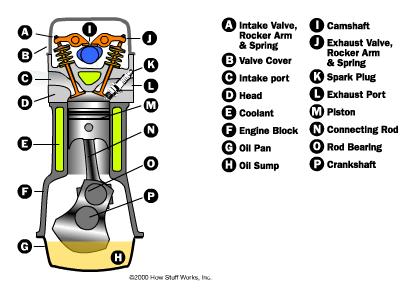How does a 4 stroke petrol engine works?

An engine, or motor, is a machine designed to convert one form of energy into mechanical energy. Heat engines, including internal combustion engines and external combustion engines (such as steam engines) burn a fuel to create heat, which then creates a force. In simpler words an
engine is a machine with moving parts that convert power into motion. It can be
broadly classified:
According to the type of cycle
i.)
Otto Cycle (Air Cycle)
ii.)
Diesel Cycle
iii.)
Dual Cycle
According to the alignment of cylinders
i.)
In Line type
ii.)
V type
iii.)
Rotary type
According to the speed
i.)
Low speed
ii.)
Medium Speed
iii.)
High Speed
According to the type of ignition
i.)
Spark ignition
ii.)
Combustion ignition
According to the type of fuel used
i.)
Petrol
ii.)
Diesel
According to the number of strokes
i.)
2 Stroke
ii.)
4 Stroke
There are few more types.
In this post we will understand about how a petrol engine
works. A petrol engine is based on the principle of Otto cycle (Air Cycle). It
can be either 2 stroke or 4 stroke. In this articlewe will see how the 4 stroke
petrol engine works.
1.)
Suction Stroke
2.)
Compression Stroke
3.)
Power Stroke
4.)
Exhaust Stroke
The main important parts of the engine are the piston, the
crankshaft, the connecting rod and the cylinder block which includes the
cylinder head. The cylinder head comprises of the rocker arm and spring
mechanism which with the help of a cam controls the opening and closing of the
inlet valve and exhaust valve. The cylinder block is surrounded by water
jackets which helps for cooling of the cylinder block. The parts of the
cylinder are shown below.

Suction Stroke
The first stroke is suction stroke. In this stroke, the
piston moves from TDC (Top Dead Centre) to the BDC( Bottom Dead Centre), which
are the two extreme most positions of the piston. When the piston moves from
TDC to BDC the inlet valve opens through which fresh charge (atmospheric air + petrol)
is sucked in.
Compression Stroke
The second stroke is the compression stroke in which the
piston moves from BDC to TDC. When the piston moves from BDC to TDC the inlet
valve closes and the charge is compressed thereby increasing its temperature.

Power Stroke
The third stroke is the power stroke which is the most important
stroke in which the piston moves from TDC to BDC. When the piston is at TDC the
spark plug makes a spark inside the cylinder block thereby igniting the charge
hence combustion takes place inside the cylinder block and displaces the piston
from TDC to BDC. The main power of the engine is generated from this stroke.
Some amount of power is stored the flywheel to execute the other three strokes
and the rest of the power is used to drive the wheels of the car. The inlet and
the exhaust valves remain closed.
Exhaust Stroke
The fourth stroke is the exhaust stroke in which the piston
moves from BDC to TDC. The hot gases and the fumes which are generated from
combustion of the charge are pushed out through the exhaust valve which opens when
the piston moves from BDC to TDC.
The Otto Cycle graph is shown as follows

Constant Volume Process: Heat is rejected and received at
constant volume.





0 comments:
Post a Comment